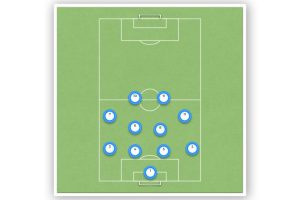The Pros and Cons of Using the Diamond Formation in Soccer: A Comprehensive Analysis
I have been playing soccer for many years and have seen various formations used on the field. One of the most popular formations is the diamond formation, also known as the 4-4-2 diamond formation. This formation features four defenders, four midfielders, and two forwards arranged in a diamond shape.
There are several advantages and disadvantages to using the diamond formation in soccer. One of the main benefits is its versatility. The diamond formation can be used to defend deep or attack with pace and width. It also provides a good balance between defense and attack, making it a popular choice for many coaches and teams.
However, there are also some downsides to using the diamond formation. One of the main drawbacks is the absence of wingers, which can limit the team’s ability to play wider on the field. This can be a problem when defending against teams with side players and can also make it more difficult to create scoring opportunities.
What is the Diamond Formation?
The diamond formation is a soccer formation that consists of four defenders, one defensive midfielder, two central midfielders, and two forwards. This formation is called a diamond because the midfielders are arranged in a diamond shape. The formation is also known as 4-4-2 diamond, as it has four defenders, four midfielders, and two forwards.
The diamond formation is a flexible formation that can be used in both attacking and defensive situations. It allows teams to control the midfield and create chances through the middle of the field. The diamond formation is also effective in pressing high up the field, as the midfielders can quickly close down opponents and win the ball back.
However, the diamond formation also has some drawbacks. It can be vulnerable to attacks down the wings, as it lacks wide midfielders who can track back and defend. This can leave the fullbacks exposed and create gaps in the defense. Additionally, the diamond formation requires the central midfielders to have a high work rate and cover a lot of ground, which can lead to fatigue later in the game.
Pros of Using the Diamond Formation
Increased Possession and Control
One of the biggest advantages of using the diamond formation is the increased possession and control of the midfield. With four midfielders in a diamond shape, the team can dominate the center of the field and control the pace of the game. This allows for more opportunities to create scoring chances and limit the opposition’s chances.
Effective Defense and Midfield Control
The diamond formation also allows for effective defense and midfield control. The defensive midfielder can drop back and join the defensive line, becoming a third center back. This creates a solid defensive foundation while also allowing the other midfielders to push forward and support the attack. The diamond formation also allows for quick transitions from defense to offense, as the midfielders are in close proximity to each other and can quickly move the ball up the field.
Creating Space for the Attackers
Another advantage of the diamond formation is that it creates space for the attackers to operate. With the midfielders controlling the center of the field, the attackers have more room to move and create scoring chances. The diamond formation also allows for more flexibility in the attack, as the wingers can push forward and join the attack while the fullbacks provide defensive cover.
Cons of Using the Diamond Formation
Limited Width
One of the major drawbacks of using the diamond formation is the limited width it provides. With only one player occupying the wide areas of the field, the team can struggle to create chances from the flanks. This can make it easier for the opposition to defend against the team, as they can focus their defensive efforts on the center of the pitch.
Vulnerable to Counter-Attacks
Another disadvantage of the diamond formation is that it can be vulnerable to counter-attacks. With the central midfielders pushed up the field, the team can be exposed to quick breaks from the opposition. This can be especially problematic if the opposition has fast and skillful wingers who can exploit the space left by the diamond formation.
Lack of Flexibility
The diamond formation is also criticized for its lack of flexibility. Once the team is set up in this formation, it can be difficult to switch to a different formation mid-game. This can limit the team’s ability to adapt to changing circumstances, such as injuries or changes in the opposition’s tactics.
Overall, while the diamond formation can be effective in certain situations, it is not without its drawbacks. Teams considering using this formation should carefully weigh the pros and cons before making a decision.
Conclusion
After researching and analyzing the diamond formation in soccer, I have found that it has both its strengths and weaknesses. It can be an effective formation in certain situations, but it may not be the best choice for every team.
One of the main advantages of the diamond formation is its ability to control the midfield. With four central midfielders, the team can dominate possession and create scoring opportunities. Additionally, the formation can be flexible and adjusted to suit the team’s strengths and weaknesses.
However, the diamond formation also has its drawbacks. One of the main disadvantages is the lack of width. Without wingers, the team may struggle to attack down the flanks and may be vulnerable to counterattacks. Additionally, the formation requires a high level of discipline and organization from the players, which may be difficult to achieve with a less experienced team.
Ultimately, whether or not to use the diamond formation will depend on the team’s specific needs and strengths. Coaches should carefully consider the pros and cons before deciding to implement this formation.







